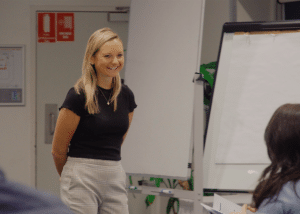CASE STUDY
How CHEP have adopted HOP to improve safety, engagement and how work is done
Global supply chain company CHEP started implementing Human and Organisational Performance (HOP) with a pilot in Queensland in 2019. Since then, the organisation has embraced HOP and Learning Teams throughout their APAC operations, and the results have been astounding.
Despite the challenges of 2020, CHEP’s focus on using the HOP principles within their facilities didn’t stop – primarily to ensure valuable conversations continued – and showed in the strength of their year-on-year results.
HOP is weaved throughout four key business pillars: exceptional leadership, staff engagement, safe processes, and supporting systems.
The results are examined holistically across the business regarding outcome measures. However, some of the most notable high-level outcome measures (lag indicators) in the Asia-Pacific region for the year were:
• A 30% improvement in reportable injury frequency rate in FY20 compared to FY19
• 83% of locations were reportable injury-free
• A 64% reduction in injury severity rate, translating to an almost 70% reduction in Workers’ Compensation payouts
When starting with HOP, they set an initial goal to no longer have any significant incidents – and this has been achieved. Understandably, there are still incidents, but since implementing HOP, the nature of those incidents has changed. They no longer have significant incidents, and injuries are much more minor.
The lead indicators have been the most outstanding from a holistic reflection of how safety is progressing in the business.
HOP has enabled a significant shift in its training model, which is now done by verifying competency methods and one-on-one conversations on the floor rather than traditional classroom training.
Looking at the number of reported hazards and near misses, they exceeded their target by over 40%, with a 99% close-out rate of actions arising from those hazards and Learning Teams within the year.
The most gratifying results have been seen in:
-
-
The number of identified hazards
-
Improvement in the number of Learning Teams completed
-
Action close-out rate from actions arising from the Learning Teams improved
-
A noticed improvement in a routine safety activity where people are more open to sharing problems, even where they had to operate in contradiction to a procedure
-
Workers are starting to ask for Learning Teams
-
300 actions flowing from Learning Teams in a year
-
A vital indicator of the workers’ response to CHEP’s safety journey was highlighted in a Pulse Survey taken in 2020, where the response to the safety question was the highest-rated response overall out of all the questions in the survey put to the employees – achieving 87/100, which was an increase on the previous year.
HOP has also provided a new tangent to existing activities. CHEP has adapted safety activities with a HOP approach, including their ‘Take45’ leadership and operator safety walks, which now incorporate story-telling opportunities.
Traditional ‘Stop for Safety’ sessions – which would see workers gather and stop work for a session emphasising a safety aspect – have been transformed from focusing on people’s behaviours to conversation-based sessions where workers share where they are experiencing difficulties.
CHEP has found that outcomes that flow from operational learning directly improve outcomes for their people, as they have been part of the ideation and solution development.
HOP is a vehicle that allows CHEP to explore situations differently to get a better-quality outcome on key risk focus areas.
Where to from here?
CHEP can now progress with the HOP principles firmly embedded in their APAC operations. While they will maintain a HOP focus across the four key pillars, the following steps will be:
-
-
Build their pool of Learning Team Facilitators
-
Develop the use of HOP in informal ways, including a whole-of-business ‘Safer Together’ initiative!
-
Get more benefit from the use of the HOP principles beyond Learning Teams
-
Encourage taking a walk in someone else’s shoes every day rather than just during a Learning Team
-
Work on having HOP-style conversations between leaders and their people, inviting feedback daily.
-
Enable leaders to have curious conversations, with the ability to invite stories that provide insight into standard work and where challenges lie.
-
Create materials to advocate questions, inviting stories as the language used on the floor.
-
Improvements beyond safety
The benefits of incorporating HOP and Learning Teams at CHEP are not just felt within safety. They have extended to operations – and beyond – improving how work is done across the board. These examples show just how effective the approach has been, with the flow-on effects improving productivity, workplace constraints and communication.
Pumping the brakes on jams
Challenge: Part of a particular line at one facility was continuously jamming and presenting difficult isolations. The issue had been ongoing for a number of years.
Solution: An outcome out of the Learning Team was to install a plate that cost $100. This simple, low-cost solution has all but eliminated jams, has completely removed the requirement to complete energised work in that area, and improved access through the area. A game changer!
Result: Stopping line jams has improved safety, productivity and access
Going with the Flow
Challenge: A source of frustration in one part of a pallet line was that pallets would bank up and operators would need to call out to others to slow the line to avoid jams and stoppages to the line.
Solution: The solution was identified as an outcome of a Learning Team, where there was a query about whether there could be sensors installed on the line to pick up when the line was full. It was outlined that if there was a sensor in a particular location they would get earlier warning, which meant that they could better control the flows and prevent jams earlier.
Throughout the Learning Team with stories building on each other, it was discovered that they had a sensor previously like that which they outlined, although it had been removed at some stage and was never replaced. Following on from this, the sensors were located, repaired and reinstalled.
Result: Early detection of pallets banking up has improved productivity (and sanity) through decreased line stoppages. Line stoppage time has significantly decreased. This was a fix that was in-house, cost effective, and decreased frustration.
Don’t judge a book by its cover
Challenge: There was an incident where a person was hit with a forklift resulting in a minor injury, but it could have been much worse. It happened on small site with no reportable injury for many years (a good example that the absence of incidents is not necessarily the presence of safety).
At face value, it appeared to be a pedestrian going into what should have been a ‘no-go zone’ forklift area. Initially it looked like a violation of procedures.
Solution: CHEP took a HOP approach with the investigation. Subsequently, the findings revealed that it was a combination of work area layout challenge and a design shortcoming of an infeed line on a separate piece of equipment.
Result: Taking a HOP approach with incident response transformed what initially looked like a one-off incident and violation into a deeper understanding of the problems and constraints that were happening every day. This approach allowed for open and honest conversation, revealing some constraints and difficulties that were present every day for the staff at that site. This allowed them to work on these difficulties – rather than focusing on the behaviour of an individual – and focusing on actions relating to this.
“Could you buy us a clock?”
Challenge: In wash facilities, tasks are rotated every 30 minutes to overcome manual task challenges and reduce risk. Through the use of Learning Teams, it was found that the rotation time was erratic (between 30 and 90 minutes).
Solution: A clock was requested as something visual they could refer to, while maintaining autonomy.
Result: Taking this approach identified a problem that hadn’t been picked up previously where a simple, cost-effective solution could help reduce the risk of musculoskeletal injury. Additionally, as a worker-driven solution, there was an immediate change in willingness to report.
It takes two
Challenge: Line clearing is safer with two people. However, in a Learning Team it was discovered that a person on the line would need to go to different areas of the site to find someone to assist.
Solution: Two-way radios were requested and provided, which significantly improved the speed and ease of communication between staff.
Result: The outcome has made it easier to enable a two-person line clearing – therefore making it safer – as well as improving productivity by reducing the time spent finding a second person. As an additional benefit, it has improved communication between staff overall in the sites.

Key takeaways for CHEP
- The big change CHEP have identified since commencing with HOP is how they engage with their people.
- HOP is weaved into the key pillars of the business – not just safety.
- Learning Teams intentionally started with operational problems that are relevant to those doing the work (rather than starting with incidents).
- Learning Team facilitators are required to listen with impartiality. Avoid facilitators who are in the chain of command of people in the room.
- Use a simple slide-deck before the start of a Learning Team to familiarise Learning Team participants with the concepts.
- Beware of doing too much of a good thing – CHEP did a lot of Learning Teams in a short amount of time and learnt from this process. The amount of information that flows in Learning Teams is significant. Ensure there is capacity to follow-through on findings, and action these within a committed timeframe.
- With their continuing focus on expanding the use of HOP in informal ways, it is expected that less Learning Teams will be needed as the concerns will be raised quickly and addressed quickly with a few actions required.
- HOP helps and enhances due diligence and legal obligations. The PCBU and officers have a duty to understand the risks associated with their work environment and processes and to eliminate or control those risks. Until there is a deep understanding of the reality of how work is done – the Blue Line – there cannot be a true understanding of the reality of the risks in the workplace. HOP in itself is a way of getting a much better understanding of the risks, even after formal risk assessments. It can be a valuable tool to enable the PCBU and officers of the business to more fully understand what their processes are.
- HOP is an international language. The approach will work wherever people are working within a process. CHEP are seeing some slight differences with cultures but it is equally applicable in all cultures – they are seeing great results globally across diverse cultures and countries.
Top tips on doing HOP
- Pick a pilot area. Once there is feedback and participation from the pilot, seek leadership and support. This approach provided CHEP with the ability to take the findings from the pilot to demonstrate success and give leadership confidence to support the program.
- Start small! It cannot be an off-the shelf or package program. It is a change in thought process.
- Use early adopters – people from the pilot area – to advocate across the business
- Spend time explaining why you are doing HOP with the people involved – including the benefits – and ensuring people know what the principles are (e.g. at the start of Learning Teams)
- Start with proactive Learning Teams (not after an event)
- Get the people and business accustomed with the process, and then you can start to utilise it after events
- Listen without judgement, and emphasise it is a no-blame conversation
Final take-home points
HOP is a change in thought process of the business in relation to how they see their people. It is about truly understanding people. Have the courage to take a different path to be able to achieve that next step change of safety culture within the business.
When looking at success of a program or approach like this, look at safety holistically. Ask yourself – what are those holistic indicators? There will be outcome measures, but make sure that you’re also measuring and focusing on measures of safety capacity.
Increase engagement and enhance performance.
Read about the phases of HOP and see how a seed of interest can develop into a Learning Organisation that applies HOP and improves performance across every area of operations.








